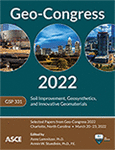Reactive Transport Modeling of Microbial Induced Calcium Carbonate Precipitation Utilizing Various Configurations of Injection Wells
Publication: Geo-Congress 2022
ABSTRACT
While experimental studies on the use of microbial-induced calcium carbonate precipitation (MICP) for soil improvement have focused on assessment of cemented soil properties, there is a gap between small-scale laboratory experiments and modeling for the design of large-scale field implementation. Numerical analyses are conducted herein to explore the influence of various layouts and configurations of injection wells in delivering effective deployment of the MICP process. Metrics of evaluation include continuity and level of cementation as well as associated by-products. The bacterial transport/attachment/decay, and ureolysis rate parameters are included in the transport model. The model is calibrated using column-scale experimental data. Under the same flow rate and injected volumetric solutions, results indicated that 2-, 3-, and 4-well configurations with distance between wells equal to 1 m produce the highest average CaCO3 in the target area. Among the well configurations which induce the highest CaCO3 content, 4-well configuration with 1 m distance between wells provided more uniform distribution of CaCO3 (less standard deviation), with relatively lower by-product ammonium (NH4).
Get full access to this article
View all available purchase options and get full access to this chapter.
REFERENCES
Barkouki, T., Martinez, B., Mortensen, B., Weathers, T., DeJong, J., and Spycher, N. (2011). “Forward and inverse bio-geochemical modeling of microbially induced calcium carbonate precipitation in half-meter column experiments.” Transport Porous Med, 90, 23–9.
Cuthbert, M. O., McMillan, L. A., Handley‐Sidhu, S., Riley, M. S., Tobler, D. J., and Phoenix, V. R. (2013). “A field and modeling study of fractured rock permeability reduction using microbially induced calcite precipitation.” Environmental Science & Technology, 47, 23.
DeJong, J. T., Mortensen, B. M., Martinez, B. M., and Nelson, D. C. (2010). “Bio-mediated soil improvement.” Ecol. Eng. 36:197–210.
Ebigbo, A., Phillips, A., Gerlach, R., Helmig, R., Cunningham, A. B., Class, H., and Spangler, L. H. (2012). “Darcy-scale modeling of microbially induced carbonate mineral precipitation in sand columns.” Water Resources Research, 48, W07519.
Faeli, Z. (2021). Reactive flow and transport analysis in unsaturated and saturated subsurface profiles. Ph.D. Thesis, Department of Civil Eng., North Carolina State University, NC.
Ferris, F. G., Stehmeier, L. G., Kantzas, A., and Mourits, F. M. (1996). “Bacteriogenic mineral plugging.” J. Can. Pet. Technol. 35(8), 56–61.
Ghasemi, P., and Montoya, B. M. (2020). “Field application of the microbially induced calcium carbonate precipitation on a coastal sandy slope.” Geo-Congress, Minneapolis, ASCE.
Minto, J. M., Lunn, R. J., and El Mountassir, G. (2019). “Development of a reactive transport Model for field‐scale simulation of microbially induced carbonate precipitation.” Water Resources Research, 55, 7229–7245.
Montoya, B. M., Do, J., and Gabr, M. A. (2021). “Distribution and properties of microbially induced carbonate precipitation in underwater sand bed.” ASCE Journal of Geotechnical and Geoenvironmental Engineering, 147(10): 04021098.
Nassar, M. K., Gurung, D., Bastani, M., Ginn, T. R., Shafei, B., Gomez, M. G., Graddy, C. M. R., Nelson, D. C., and DeJong, J. T. (2018). “Large-Scale experiments in microbially induced calcite precipitation (MICP): reactive transport model development and prediction.” Water Resources Research, 54, 480–500.
van Paassen, L. A. (2009). “Biogrout: Ground improvement by microbially induced carbonate precipitation.” Delft University of Technology, 64(1), 46–51.
van Wijngaarden, W. K., Vermolen, F. J., van Meurs, G. A. M., and Vuik, C. (2011). “Modelling biogrout: A new ground improvement method based on microbial-induced carbonate precipitation.” Transport in Porous Media, 87, 397–420.
Information & Authors
Information
Published In
History
Published online: Mar 17, 2022
Authors
Metrics & Citations
Metrics
Citations
Download citation
If you have the appropriate software installed, you can download article citation data to the citation manager of your choice. Simply select your manager software from the list below and click Download.
Cited by
- Marlee Reed, Emily Berglund, Brina Montoya, An Agent-Based Modeling Perspective of Bio-Mediated Ureolysis, Geo-Congress 2024, 10.1061/9780784485309.046, (446-455), (2024).
